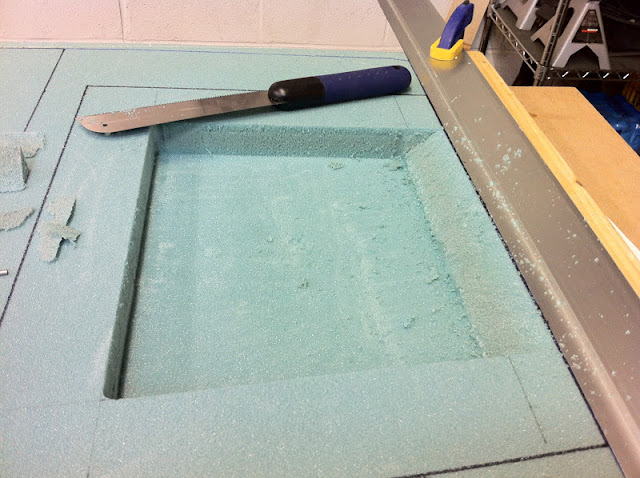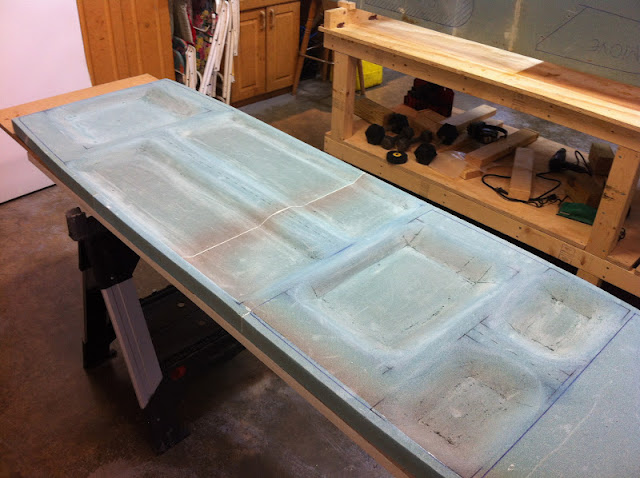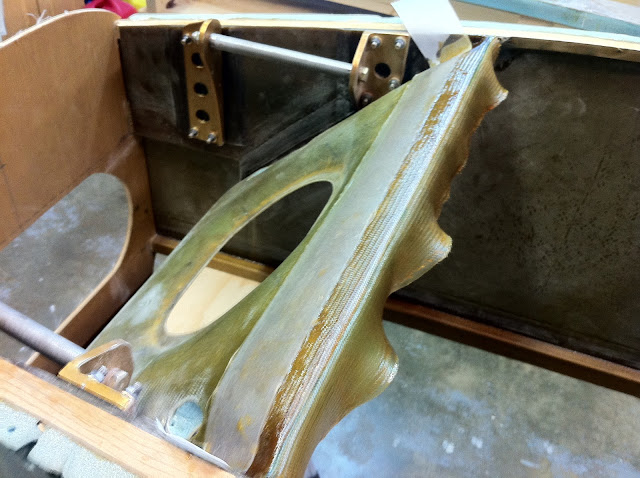Fuselage bottom (17.2 hrs)
After getting the foam panels from Wicks, I sat them in place to check their dimensions.
 |
| Foam pieces covering the bottom of the fuselage |
As you can imagine, the pieces had to be first bonded together with micro.
 |
| Micro in place to bond the panels together |
 |
| Bottom panel curing |
Because my fuselage is 2” wider, the regular 24”x48” panels were about 1.5” too narrow to cover the complete width of the fuselage bottom.
 |
| This foam is too narrow to cover the entire bottom of the plane |
Since the plans required that I trim the rear foam panel 0.25” past the back seat, this left me with plenty of leftover foam, which I then sliced into 2” strips, and used to fill in the missing width.
 |
| Additional strips glued to the side |
 |
| Coverage is now 100% |
Next step was tracing the bulkheads layout onto the foam floor from the inside. To accomplish this, the fuselage had to be moved back on the sawhorses, upside down.
 |
| I had to crawl inside the fuselage with a Sharpie |
 |
| This are the outlines of the bulkheads I traced while inside the fuselage |
Later, I drew the outline of the new aircraft bottom 0.7” outboard of this line, and used a saber saw to cut the foam along the outer one.
 |
| The outer line represents the outer edge of the fuselage |
A few more changes to the floor layout were necessary due to the fuselage width change, as well as the moving of the front seat 2” forward.
 |
| Brainstorming session caught on paper |
As far as the shapes of the parts to be scooped out are concerned, I ended up first drawing their outer edges, then calculating and drawing an inner line representing the closest place to the outer edge with a full depth of cut.
 |
| Rear seat contour lines |
Using a router, I dug along this inner line at full published depth.
 |
| No going back now! |
Then again, to clear up all the rest of the foam.
 |
| Getting the rest of the foam out was more fun |
This inner lines were prepositioned to achieve the angles required by the plans, 45˚ for the back side of both seats, matching the seat slopes, and 30˚ for the front of both seats. Everywhere else the angles were left to the builder, so I just doubled the depth of the particular cut, and drew the line inboard by that amount, this turned out to be 26˚, which should be nice and shallow for the fiberglass to follow with ease.
With the math sorted out, I cut along the diagonal connecting outer and inner lines, and went on to sand, sand, sand.
 |
| Rear seat, rear slope at 45˚ |
 |
| Rear seat, side slope at an arbitrary 26˚ |
 |
| Rear seat, front slope at 30˚ |
I used the same process for the rest of the fuselage bottom.
 |
| A lot more router action |
I ended up needing a short recess for lunch, because I started seeing crazy things in the foam...
 |
| "Behold the Long EZ Tiki God!" |
With my belly full, I felt much better and the visions disappeared, so I moved on to trying different cutting implements.
I eventually settled on coarse saw, with a pretty stiff blade. This produced a rougher finish, but it did so in a fraction of the time, and since every tool I tried still required further sanding, the initial surface finish didn’t really matter.
 |
| Having a go at it with the Dremel |
 |
| This took way too long, and was pretty stressful. |
 |
| This ugly old saw did the trick |
 |
| I had this roughed out in no time |
It felt like sanding went on forever though, and I actually disintegrated 3 sheets of 30 grit and 2 of 80 grit.
 |
| All contours aft of the instrument panel finished |
 |
| It still looks a little rough now, but it will be great once micro, epoxy and fiberglass do their thing. |
Finally I flipped the fuselage back onto the bottom piece to make sure things were fitting alright, and I was pleased with the results. The seat lines flowed smoothly into the carved foam, and all the bulkheads lined up precisely.
 |
| Looking a bit tiny, I hope I didn't screw it up! I can't wait to get in there to try it on for size. |
 |
| The rear space looks palatial by contrast |
I did not carve forward of the instrument panel yet, because the fiberglass nose wheel cover I need to trace on the foam, has not arrived yet but it should be home about the same time I get back, so I will get on with it next week.


































